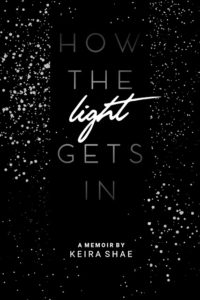 On July 24, BCC Press will publish How the Light Gets In by Keira Shae. This memoir is the story of a girl growing up in a poor, non-Mormon family in the predominantly orthodox LDS (Mormon) community in Provo, Utah, USA. The Rocky Mountains and desert environment form the backdrop of this small suburb. The book describes her mentally ill, uneducated, prostitute, single mother raising five children and succumbing to addiction to methamphetamine. In this harrowing memoir Keira encounters physical, emotional, and sexual abuse, homelessness, family separation, and profound poverty in the shadow of the Temple and the LDS Church’s flagship university. Under duress, Keira becomes a runaway teen, seeking shelter with her Christian neighbors until police placed her in child protective service’s custody. She eventually converted to the Church after experiencing kindness from an LDS foster family. Here is a small taste of what you will encounter in this wonderful, terrifying, and ultimately transcendent true story.
On July 24, BCC Press will publish How the Light Gets In by Keira Shae. This memoir is the story of a girl growing up in a poor, non-Mormon family in the predominantly orthodox LDS (Mormon) community in Provo, Utah, USA. The Rocky Mountains and desert environment form the backdrop of this small suburb. The book describes her mentally ill, uneducated, prostitute, single mother raising five children and succumbing to addiction to methamphetamine. In this harrowing memoir Keira encounters physical, emotional, and sexual abuse, homelessness, family separation, and profound poverty in the shadow of the Temple and the LDS Church’s flagship university. Under duress, Keira becomes a runaway teen, seeking shelter with her Christian neighbors until police placed her in child protective service’s custody. She eventually converted to the Church after experiencing kindness from an LDS foster family. Here is a small taste of what you will encounter in this wonderful, terrifying, and ultimately transcendent true story.
I remember walking and holding my grandmother’s rough hand in my left hand, and running my fingers down the spines of the books with my right. It was between these two things I had solace in such a terrifying childhood. I searched high and low and found stories of brave cowboys, resilient survivors, eccentric artists, kind princesses, and magical animals. They were my friends. They gave me hope that there was meaning and purpose in struggle.
But none of them were my story. I began to wonder if my story would end happy, too.
That is why I wrote this book; for all the Keiras of the world who need to know that they will find safety and peace. That included myself.
This book was my therapy for five years. My husband, an avid believer in stories, convinced me to write it all out so it would stop haunting my nightmares. It was a painful process, but he was right. The poison drained out of me as soon as I let the words come out. Putting labels on the experiences validated why my soul felt so shattered. I felt physically ill describing the sexual abuse and the truckload of shame that came with it. I cried as I wrote the little mantras my mother used to chant to me to intimidate me and make me comply. I used writing like a punching bag when my anger percolated at the injustice I suffered.
Between the support of my best friend and husband, Nick, and the love of a make-shift family from beloved teachers, neighbors, and my former foster family, I went to therapy, wrote my book, and started speaking on behalf of victims. My biological family has not been happy with my decision to write or publish it, as it reveals family secrets and hidden pain. I’ve learned that speaking truth can be very healing. I have created my art out of the rubble of my life.
I hope this book makes us better and more empathetic neighbors, church members, friends, family, and citizens. If there is a fellow-sufferer out there like me, know that your art and expression can be therapeutic. Know that something beautiful can come of the trials.
I named my book after this stanza in Leonard Cohen’s song, “Anthem”:
Ring your bells that still can ring;
Forget your perfect offering.
There is a crack–a crack in everything:
That’s how the light gets in.
We are not beautiful despite our cracks, but because of our cracks.
I wish you light in all your pain.

Thanks! This talk of “beauty from the cracks” reminds me of a couple of recent posts on Kintsugi (金継), a Japanese art where an artist takes a broken piece of pottery and repairs/highlights the cracks with lacquer mixed with flakes of gold or silver (or gold or silver colored material). An obvious metaphor, I look forward to using it in my next sacrament talk.
https://www.the-exponent.com/kintsugi-focusing-on-the-cracks/
https://bycommonconsent.com/2017/02/24/repaired-with-gold-on-perfection-the-atonement/
https://www.lifegate.com/people/lifestyle/kintsugi